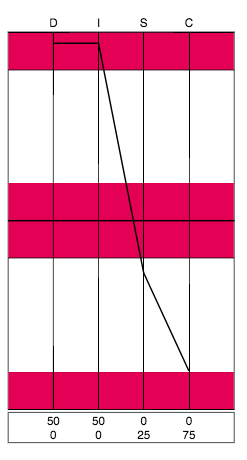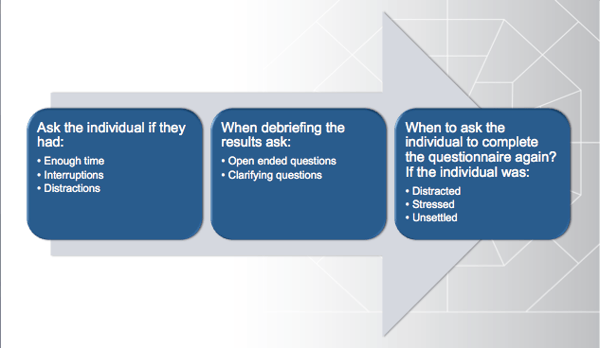It should always be the first question you ask when you receive DISC assessment results.
We get into trouble by jumping straight into interpreting the results too quickly. The first question we should always ask is, "can I trust the results?" Our clients need accurate identification of their natural styles in order to know how to make successful behavioral adjustments.
Would you want your doctor to have inaccurate data to treat you?
 Imagine if you went to your doctor with a health issue that you needed to have treated. Your doctor orders a MRI to help identify the problem and determine the course of treatment. What if the MRI results were fuzzy and unclear, yet they went ahead and began your treatment anyways? How confident would you be that your doctor is basing the treatment off of valid information? I would guess "not very."
Imagine if you went to your doctor with a health issue that you needed to have treated. Your doctor orders a MRI to help identify the problem and determine the course of treatment. What if the MRI results were fuzzy and unclear, yet they went ahead and began your treatment anyways? How confident would you be that your doctor is basing the treatment off of valid information? I would guess "not very."
Oftentimes, other DISC tools allow random or consciously selected answers, which will generate a DISC result, albeit misleading. Some will even force generate a result. Important decisions may be made based on this inaccurate information and could lead to misaligned roles and other issues. Extended DISC®tools have built-in validity checks to ensure the results are accurate. so confident decisions about behavioral modification can occur. The Extended DISC® tools lets you know you that you're working with valid measurements of the person's natural style. The tools also have in place how to read results with less validity.
How to identify valid results
Extended DISC tools measures two things. We measure a person's perceived need to adjust in their present environment and their natural style. We focus primarily on the person's natural style. Natural hard-wired style describes a person's most comfortable way of doing things. It remains fairly stable, but not rigid, over one's adult life. It shows who the person really is by identifying behaviors which are most comfortable and use the least amount of energy.
 We can be confident in the validity when we see a tall (vertically stretched) Extended DISC Profile® result. We can trust this result because it indicates a consistent response pattern. It means the person clearly and consistently chose the DISC style(s) which was most comfortable to them over the DISC style(s) which was not. How do we know?
We can be confident in the validity when we see a tall (vertically stretched) Extended DISC Profile® result. We can trust this result because it indicates a consistent response pattern. It means the person clearly and consistently chose the DISC style(s) which was most comfortable to them over the DISC style(s) which was not. How do we know?
In the example above, the person consistently selected the D-style and I-style answers as being most comfortable (two styles plotted above the middle line). At the same time, the person consistently selected C-style, and a lesser extent, S-style, answers as being least comfortable (below the middle line). The larger the gap between their most comfortable natural style (above the middle line) and their least comfortable style (below the middle line) the more confident you can be in the results. The person has consistently identified what is most natural, over what is not natural.
How to identify results with less validity
 In the example above, every one of the graphs show the individual's Natural Style profile as a DI profile combination. The shape is similar; D-styleand I-style are above the line and S-style and C-style are below the line. However, there are distinct differences in the size of the profiles. They vary from tall and vertically stretched graph lines on the right; all the way to tight and compressed graph lines to the left.
In the example above, every one of the graphs show the individual's Natural Style profile as a DI profile combination. The shape is similar; D-styleand I-style are above the line and S-style and C-style are below the line. However, there are distinct differences in the size of the profiles. They vary from tall and vertically stretched graph lines on the right; all the way to tight and compressed graph lines to the left.
The consistency of the person's answering pattern determines the size of the graph line. A highly consistent response pattern (as shown on the far right) results in a tall, stretched graph line. An inconsistent response pattern results in a tight or compressed graph line. In a tight or compressed profile, the person is not clearly identifying a style, but instead, choosing more across all four of the DISC styles.
What do we do with the results that have lower validity?
 When you receive DISC results, decide if you can trust the results. If there is a clear stretched profile, then you can confidently proceed with the results. However, profiles that are more compressed alert us to use caution. It doesn't mean the client did anything wrong. In fact, we often assume the person was simply distracted or rushed when they took the questionnaire. Those distractions can cause interference in the person's answers. So, assuming it was the answering situation is always a safe place to start.
When you receive DISC results, decide if you can trust the results. If there is a clear stretched profile, then you can confidently proceed with the results. However, profiles that are more compressed alert us to use caution. It doesn't mean the client did anything wrong. In fact, we often assume the person was simply distracted or rushed when they took the questionnaire. Those distractions can cause interference in the person's answers. So, assuming it was the answering situation is always a safe place to start.
Your job, as the coach, is to present the data and help guide the individual to the interpretation of the data. When you see a compressed profile, remind yourself to ask more open-ended and clarifying questions to better understand the situation. The person lives that profile every day; no one knows the client better than the client. There may be times you ask your client to take the questionnaire again, but the compressed profile results are still valid results.
A profile that is tighter is a cautionary flag to find out more by digging deeper. However, we don't always have the luxury of conducting one-on-one sessions with our clients so this issue may not even come up. The purpose of understanding the levels of validity is to provide more information to you, as the facilitator, that is not spelled out anywhere in the assessment. Ultimately, we have confidence in our tool's results, as well as the knowledge to know when to use more caution.
